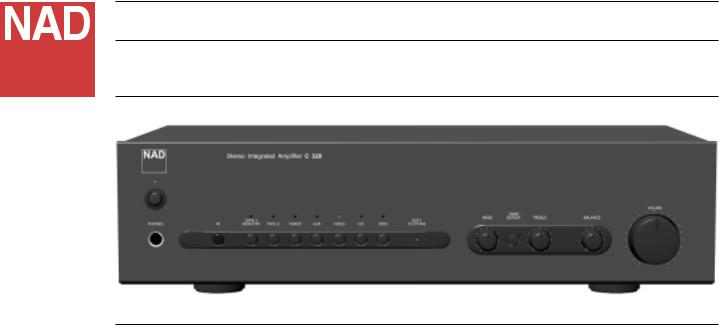NAD C320 User Manual

C320 Integrated Amplifier
Date of manufacture : July 98 - Current
Please note that this document contains the text from the original product brochure, and some technical statements may now be out of date
•2 x 40 Watts continuous into 8ohms
•90 Watts dynamic power into 8ohms
•160 Watts dynamic power into 2ohms
•Impedance Sensing Circuitry (ISC)
•Full system remote control
•Headphones socket
•Relay input switching
•Toroid power transformer
•7 Line inputs, including two tape in/outs
•All discrete circuitry
•Short signal path from input to output
•All sockets gold plated
•Tone controls defeat switch
•Pre-out / Main-in
•Soft Clipping
•NAD Link
Introducing the C320. This amplifier is the latest in the family of NAD’s modestly priced integrated amplifiers which stretch back to the legendary 3020. One step up from the splendid 310, the C320 is fully remote controlled with the NAD C Series system controller and is destined to become yet another NAD classic.
Features
The C320 has 7 line inputs (including 2 tape in/outputs with dubbing facility) and the pre-amplifier section can be separated from the power amplifier for easy upgrades (bi-amping, for instance) or adding ancillary equipment without making the C320 redundant.
Tone controls tend to come and go on amplifiers, depending on whatever is in vogue at the time. This does not mean that tone controls should necessarily be regarded as a superfluous extra. Given proper thought and design, tone controls can make a genuine contribution to overall sound quality. The C320 tone controls only work at the frequency extremes leaving the critical mid-band essentially unaltered. The tone control circuits can be completely bypassed by using the tone defeat switch.
A closer look at ISC
The NAD C320 is one of the first products to benefit from Bjørn Erik Edvardsen's latest development. ISC topology - the letters stand for Impedance Sensing Circuit - allows the C320 to deliver maximum performance under virtually any circumstance, independent of the loudspeakers it is driving. The circuitry automatically recognises the impedance characteristics of the loudspeaker and will then adjust its power supply settings to best cope with that specific load.
NAD takes a stand against the mindless “brochure power” approach which doesn't give a realistic indication of an amplifier’s true capabilities. Instead, the ISC topology is a practical approach to enable an amplifier to easily deal with dynamics and difficult loads. More meaningful are the C320’s dynamic capabilities; up to 160 Watts into 2 ohms and up to 35 amps current capability!
